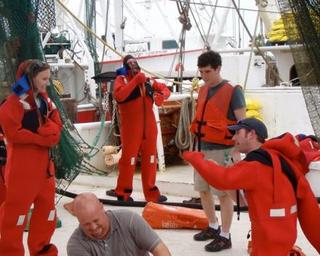Coast Guard Safety Committee Works to Standardize Training

Tuesday, November 29 2011
Commercial fishing is risky business, and managing that risk doesn’t come cheap. The Coast Guard’s Commercial Fishing Vessel Safety Advisory Committee is tasked with figuring out ways to make the industry as safe as possible without putting people out of business with burdensome costs. They meet twice a year, and they come up with recommendations for how the Coast Guard can improve its safety policy.
This month, they gathered in Seattle to discuss training standards and classification of smaller fishing vessels.
When it comes to training, the committee is working to develop a national standard curriculum that would meet Coast Guard approval over the next year. Jerry Dzugan is committee chair and serves as the executive director of the Alaska Marine Safety Education Association.
‘What we tried to do was have some guiding principles: that the training be affordable, that it be accessible and able to be delivered to someone’s homeport, that it be relevant to the fishery, that it be meaningful – like hands on training is more meaningful than a written test,” says Dzugan. “Then, we sat down and we wrote performance-based objectives for all of those things. What is the minimum competency a fisherman should have? You should be able to test an EPIRB. You should be able to launch a liferaft.”
In the meantime, the committee passed motions on what sort of certifications could substitute for the completion of a training program. Dzugan says that this isn’t a move to push fishermen into licensing, but rather a way to help some avoid redundant training.
He adds that it’s challenging coming up with training policy, given that the amount of training a fisherman has can vary.
“Some fishermen felt in training that we were going from zero to a hundred all of the sudden. Others felt like we haven’t been at zero for 30 years. For the last 25 or 30 years, there’s been a lot of training out there,” says Dzugan. “We’re not starting at zero here, and we want to take it to the next step.”
The committee was also careful to consider costs to the fishing fleet when deciding whether new vessels that are at least 50 feet in length should undergo classification, which would require annual inspections and surveys. Dzugan says that the committee determined that this process would be excessively burdensome.
“It’s very expensive to do that. Their rates are $2000 a day, plus airfare,” says Dzugan. “If you’re living in rural ports like Sand Point, Alaska, where you’ve got boats over 50 feet, sending someone from down south to Sand Point is like going from Seattle to Europe, and more expensive than a vacation you or I would take to Europe. So, the costs are really high.”
The Commercial Fishing Vessel Safety Advisory Committee is expected to discuss these topics again this spring.



